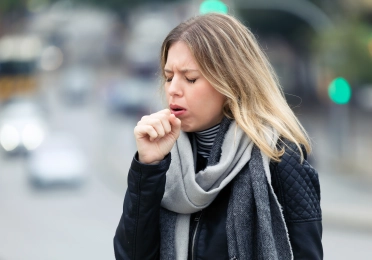Dr. Jane Frances Namatovu is a highly regarded primary care physician and lecturer at the Department of Family Medicine, School of Medicine, College of Health Sciences Makerere University Kampala. We discuss the topic Chronic Cough from her home country Uganda Africa.
Transcript
Mark:
Welcome, Jane to our podcast. Please give us a little background on yourself, your education, experience and current responsibilities. Tell us where you're located.
Jane:
Thank you very much. My name is Jen Frances Namatovu. I am from Uganda in East Africa and East Africa is in the middle of the African continent. I come from a town called Kampala. I did my education in Kampala both undergraduate and postgraduate. In my postgraduate, I did Family Medicine and Community Practice. The training is a postgraduate degree which we do for three years. Then after that, I joined the University Marquette University Department of Family Medicine as a teaching assistant.
Over the years I have moved from teaching assistant to lecturer, and I've been in the department for 15 years now. The responsibilities include mentorship for both undergraduate and postgraduate students. My current responsibility is as a lecturer in that department and a coordinator for postgraduate students.
Mark:
Wonderful. One of the most common causes of chronic cough in a non-smoker?
Jane:
Common causes include asthma, tuberculosis and then we have COPD and then Bronchiectasis and chronic bronchitis in children. There are a few patients we also get with esophageal reflux which may not necessarily be coming from the respiratory system, but they do have a chronic cough. They present with chronic cough. Those are commonest that we do have.
Mark:
Who's affected most by chronic cough and what are the treatments?
Jane:
Most of the patients that we do have asthma. The children are more than the adults. Then for chronic obstructive pulmonary disease, it's mainly still adults compared to the chronic obstructive family diseases, mainly in the adults. Then tuberculosis is both the adults and children. The children are mainly those who are predisposed. They have a member of the family who may have tuberculosis. For the adults it's mainly those who are immunocompromised, it could be from different issues, it could be diet, it could be HIV, it could be their own anti-cancer treatment. Those who are immunocompromised due to anything else in their day-to-day living, but tuberculosis is for both children and adults.
Esophageal reflux is mainly among the adults. When they come to treatments, we have inhalers and then we also have oral medication. If inhalation is not possible and commonly here in our setting the inhalers are expensive for the patients, so we find that they normally start with oral medication. If they are able to buy the inhalers, then they do and then occasionally we give them parenteral treatment.
Seeing asthma in children most health facilities can do nebulization for them. They can stabilize, but they are often sent home on oral medication. For chronic obstructive pulmonary disease, we emphasize stopping the aggravating factors. The aggravating factors can be varied depending on where the patient is coming from or where they're situated. In the history, one can see what is mainly getting the patient into exacerbations. We also help them improve their exercise tolerance and generally their health. They can reduce the exacerbations for those who have chronic obstructive pulmonary disease.
For tuberculosis, we normally start them on anti-TB treatment which includes rifampicin ethambutol. For about two weeks, they are normally contagious, so we emphasize that they isolate themselves from their family members or wear masks to ensure they don't infect other family members. Then after two weeks as they continue with the treatment, for six months, and then they can live freely. After two weeks they are not contagious.
For reflux, we normally give them antacids and then also look through their day-to-day lives to see what is aggravating the problem. Most commonly patients would be taking drinks with a lot of spices or food with a lot of spices. We try as much as possible to go through their history and see what the aggravating factors could be, making the patient get lots of esophageal reflux. Most of them are unaware so we try to help to educate them on what is bringing them problems, so they can stop. The commonest thing, which is seen to cause problems, for example, is ginger which they put in warm water in addition to other spices. It was commonest around the time of COVID because the belief was that as you get most of these spicy products, they would be able to protect you from having severe COVID symptoms.
Mark:
That is interesting. Thanks for letting us know that.
We know that chronic coughing can cause damage throughout the body. Can you explain some of that to us? Where it can cause damage, as well as what it indicates?
Jane:
The damage of chronic cough can be in different forms and one of them is chest pain, because of continuous coughing. The other one is both the back and abdominal muscles may start having pain, so the patient presents with pain in the muscles. Then the other that is also common is hemoptysis. That is normally common in tuberculosis because the patient would have been coughing for quite some time. Probably because they have not had appropriate treatments and they are continuing with destruction - continuing the destruction in their lungs but also the constant coughing would be responsible for rupture of some of the blood vessels. The small blood vessels and therefore the blood is being coughed up with the sputum. Those are the main damages that we are experiencing among patients with chronic cough.
Mark:
What is chronic cough syndrome?
Jane:
Chronic cough syndrome is when the patient may have had for more than six weeks or longer with more than one course, but also, affecting more than the structural component of their lungs. We do have patients who will have the destruction of both the bronchi and then the alveoli unlike in COPD where the destruction is in the alveoli.
It is common here, especially among the old women who have been using the traditional methods of smoke that is inhaled and damages its structures, as it is inhaled for that long and then other predisposing would include other environments that have a lot of chemicals, especially in the urban settings where we have industrialization which has also contributed to that destruction. You will find that some of the patients would come with chronic cough syndrome.
Mark:
Why is self-management important for patients with chronic cough?
Jane:
Self-management is important for patients. Much as they come to the health facilities to get the medication, they also need to have day-to-day ways to partner with the family members in managing themselves. It means that as the health provider, you must give the patient enough information fast so that they can keep themselves safe after the episode of what they have come for. They can only do this through the self-management that they have acquired at the health facility.
It is important for themselves but also for their family members because they also need to keep their family members safe. Since they are chronic diseases, the patient is going to have that disease with them and therefore they need to constantly know how best to manage themselves, so they can carry on with the chronic illness, so they are not always in hospitals with emergencies following their chronic illness which they have.
Mark:
How can self-management support be put into action? Can you give us scenarios
Jane:
If you look at for instance the asthma patients or patients with COPD - once they learn about their disease and that learning, they can only do from their primary care provider or from their doctor or from their family doctor.
The primary care person starts when they have started the conversation. It helps to support patients, to be able to support themselves and this conversation is started with the doctor, it could be a clinical officer, and whoever is giving his management would be, would have the responsibility to start that conversation. Most of the time the conversation needs to start with what has brought on the symptoms. That would include the aggravating factors which can be picked from the history as you talk to the patient to try and find out what kind of way they live, what they do, so that you are able to look through their environment or through their context and see what could be causing problems. In this conversation, there are many other things we can talk about which are practical in the first place. Before you diagnose you may talk about the things that could have predisposed the patient to go to this exacerbation. Some of the diseases they will have for a long time but what should have brought that one and that conversation will help the patients to improve the way they manage themselves.
The other practical things that are important to talk about to help the person put action, is when you talk about the issues of diet: you need to break it down by looking at what they have in their diet already or in their community. That you are not hypothetical, so you first ask them what they commonly eat, and what is available in their setting and then start from there. You can be able to make sure the diet is balanced enough to cater to what you are looking at. In our setting, we have a lot of carbohydrates so the patient will normally talk about those factors. We also have the other items which would be beneficial like vegetables and fruits which you can only emphasize, after you have found what they can access. That is a practicality: you need to first ask them what they can access and then make suggestions. Also, give the value of them having it in their diet. You want to advocate for all, you want to promote this situation.
Then the other issue that is practical is, when you're talking about exercise. It is important in managing to improve or to train their lung capacity because of the chronic cough that they are having. You must look through what the patient is able to do, depending on their age, where they are living and what kind of activities they do, their day-to-day activities.
If you make it a blanket statement of, “please let's start maybe doing exercises” then they will not be able to break it down for themselves to see what's feasible. When they come for the next visit, they will not have done, so it is important you also look through and look at the age of the patient, what's physical and what the patient does. This way you can talk about the issues of exercise in the context of what the patient is presenting. Look at the practical ones. The other issue is when we have patients that have been prescribed, especially oral medication, we find that patients just carry on with their prescriptions even past the dates. When the symptoms come back, they just go along and carry the prescription to the pharmacies to just get a refill.
One of the things that still we need to do is patient education on self-medication. Most importantly, how it would affect them if they were kept on that medication for a long time. Sometimes our patients are not aware and then they would come in with other symptoms resulting in another issue in the clinical setting. We need to talk about the medications and the effects of the medications that we have given, especially if taken without prescriptions.
That completion is another challenge for patients, for example those with tuberculosis. Efforts had been started with directly observed therapy, where the patient has a buddy. This person would be suggested by a patient who has tuberculosis and then when the patient gets the medication from the health facility. The buddy's responsibility is to ensure that the person has taken that medication at that hour. It was successful but rolling it out was not that easy. We always try as much as possible to get somebody in their family to remind this patient because they are going to take this regimen. They take this regime – they take rifampicin, isoniazid, pyrazinamide, and ethambutol - for a very long time. So they need somebody who will be able to help them go through that, so that we do not create resistance and do not have progress in treatment.
The other one is to work it out with the patient and get a constant time which the patient thinks would be able to remember to take the medication. But it's not that easy so most of the time it is important to have a next of kin or family member who would be able to help the patient to get through this. That person would come with the patient to the clinic to get the medication, especially in the first days when they're diagnosed.
The other avenue which we use is when the patients come to the unit, when there are many, is to have them do group counselling. It allows the patients to ask questions about the illness or the different units, especially those which are chronic. Other aspects of managing themselves while they are on medication or while they are living with this ailment, that one is commonly done by the nurses. Few councilors should have failed facilities, many have councillors who can do the group counselling so those are the main ones.
We do not have proper rules on if I have a prescription. If I can go to the pharmacy, I can prescribe for myself, so we do not have proper rules for self-prescription. Although that would be something that would help in improving the issues of having under treatment of chronic cough and the related diagnosis of some of the causes of the chronic cough.
Mark:
We are an international podcast and I know that a lot of our listeners are curious about how COVID impacted Africa. This is a two-part question, how are you guys doing now and are you seeing the effects of COVID treating the chronic cough?
Jane:
Yes, COVID presented a lot of new aspects to chronic cough. Most times patients who would get a chronic cough during this time would end up having less presentation to the health facilities. There was a fear that they would brand them COVID, or they would test and find that they have COVID. Therefore, the sanctions would be different but at the same time, you had patients coughing for a longer than they should be, but also because COVID was the ‘in’ thing. Sometimes for some of the primary care facilities, there was not enough diagnostics for COVID. You would find that for every person who would come in with a cough some of them would be misdiagnosed with COVID. Yet they are having other causes of the chronic cough. For instance, those with tuberculosis unless somebody said they were having already hemoptysis, or they were coughing out blood. The care provider would think twice before branding them COVID patients. We had a lot of misdiagnoses because everybody was coughing for a long time and would be quickly given the diagnosis without having to think twice, especially in areas where we didn't have enough diagnostics for COVID-19.
We also have patients who have had COVID, and they have continued to have cough and chest pain. As post-COVID symptoms first those ones are quite difficult to treat because they are also worried that either they will have COVID, even when they are tested, and it's negative, they still believe that the next episode will touch them. There are those who would still really have post-COVID symptoms, and they include a chronic cough. They would have a lot of chest pain mainly those three were our challenges with the COVID.
Mark:
This has been very fascinating to see how you treat your patients down in your region. I think that this is a problem all over the world. With COVID coming in, it is hard to diagnose and make sure that the person doesn't have a chronic cough as compared to COVID. That is kind of a fine line so hopefully our listeners have enjoyed it.
Do you have anything else to add to our podcast or say to our listeners, given the fact that most of all chronic coughs we do have risk factors?
Jane:
We have many who do tobacco smoking. This is more the crude tobacco compared to the process so the damage may be a little faster than the processed tobacco. We have a few patients who come in with cancer in the lungs. There are not many, but we do still have them. As a provider, you have to have some prescription index or cancer of their lungs because those would present also with chronic cough. Sometimes hemoptysis is among other complaints, we have also outdoor air pollution which we have already talked about. The pollutants we are getting more because of industrialization and urbanization.
Mark:
We have seen a lot of fires out in the West part of our country that has been affecting a lot of different people throughout the country. The environment really presents itself as more of a problem in a lot of our health here.
Jane:
In this country and you see that in the same in South Africa. Yes, here in Uganda we do still have lots of pollution that are now coming up. In the villages, we have issues with biomass fuel which also creates problems which are not common in other parts of, for example, South Africa. This may not be common but in the rest of the East African region, it is common.




